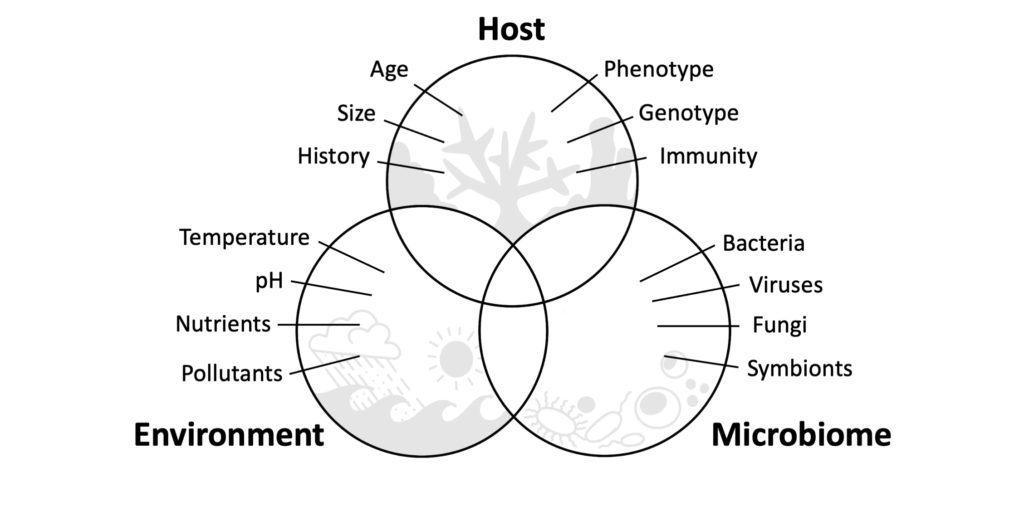Coral Disease - History and General Information
History
Coral disease was first recognized as a threat to Caribbean reefs in 1972 when Antonius (Antonius, 1973) reported the discovery of black band disease. Since that time, the number of new diseases, reef-wide prevalence, and frequency of large-scale epizootic events have risen drastically worldwide. Today, there are as many as 40 coral diseases that are reported to affect more than 200 species of scleractinian coral.
What is Coral Disease?
Disease is any deviation from, or interruption of, the normal structure or function of any body part, organ, or system that is manifested by a characteristic set of signs and whose etiology, pathology, and prognosis may be known or unknown. Coral disease is often manifested as either color change or skeletal damage and may be accompanied by tissue loss.

Coral Disease Nomenclature
The nomenclature for coral disease has evolved from field descriptions of gross visible signs of change from the ‘normal’ appearance of the coral holobiont. The Coral Disease and Health Consortium (CDHC) has attempted to standardize the nomenclature used by Galloway et al., 2007 to describe specific field conditions and to further differentiate between a field diagnosis, a morphologic diagnosis and an etiologic diagnosis. The terminology used in this webpage reflects the consensus opinion of the coral research community and is taken from two recent field guides to the identification of coral disease in the field (Bruckner, 2009; Weil and Hooten, 2010).
Through application of a series of steps, a researcher can determine a common field name for a coral lesion which can be further refined based on a morphologic diagnosis and an etiologic diagnosis. The approach consists of describing the lesion using standardized terms and recording this information on the coral disease assessment form. Once the coral lesion is described the researcher can make a field diagnosis using the diagnostic decision tree and the coral disease identification keys.
Uncharacterized Diseases
Many coral diseases have not been characterized under peer-reviewed venues. At the present time much confusion and disagreement exists about these diseases within the non-peer reviewed literature. Contradictory descriptions are found on various disease identification cards and web sites (for example, the same name of “red band disease” has been given to five very different observations of cyanobacteria on corals). To ensure high quality presentation of coral disease knowledge, we have chosen a path no less than that of coral disease journals; namely, to focus only on disease characterizations supported by documented (peer-reviewed) data.





Characterized Diseases
Diseases are defined by agreed upon characteristics that describe their field and morphologic diagnoses using standard terminology. The final step of confirming a disease state involves collecting sufficient information that may include performing a test of Koch’s postulates, identifying the causative agent or identifying a significant compendium of evidence indicating the presumed disease state. Browse more information on some common coral diseases.
The Environment and Coral Disease
One of the most important, yet least understood, aspects of coral disease is the relationship between disease incidence and the environment. While it has been suggested that the recent increase in coral diseases is associated with a decline in reef environmental quality, very little quantitative work has been carried out in this area. We now know that five coral diseases are positively correlated with high water temperature – these are bacterial bleaching, black band disease, plague, aspergillosis and dark spots disease.
Nutrient (sewage) input, sedimentation, and runoff have all been cited as correlated with disease incidence, however in almost all of these reports no data are provided. Only two quantitative studies to date have revealed statistical relationships between water quality factors and disease prevalence. Kim and Harvell (2002) demonstrated positive correlations between the prevalence of aspergillosis and both elevated dissolved inorganic nitrogen and slightly lower water clarity. Kuta and Richardson (2002) found that black band disease incidence was correlated with elevated concentrations of nitrite (and lower concentrations of soluble reactive phosphate). This research area is critical.

References
Antonius A. (1973) New observations on coral destruction in reefs, Abstract, Tenth Meeting of the Association of Island Marine Laboratories of the Caribbean, University of Puerto Rico, Mayaguez, PR. pp. 3-3.
Bruckner A.W. (2009) Field Guide to Western Atlantic Coral Diseases, USDC National Oceanic and Atmospheric Administration, Silver Spring, MD.
Dorland W.A.N. (2006) Dorland’s Illustrated Medical Dictionary, Saunders, W.B. .
Galloway S., Work T., Bochsler V., Harley R., Kramarsky-Winters E., Mc Laughlin S., Meteyer C., Morado J., Nicholson J., Parnell P., Peters E., Reynolds T., Rotstein D., Sileo L., Woodley C. (2007) CDHC Workshop: Coral Histopathology II, NOAA Technical Memorandum NOS NCCOS 56 and CRCP 4, National Oceanic and Atmospheric Administration, Silver Spring, MD. pp. 83.
Galloway S.B., Bruckner A.W., Woodley C.M. (2009) Coral Health andDisease in the Pacific: Vision for Action NOAA Technical Memorandum NOS NCCOS 97 and CRCP 7, National Oceanic and Atmospheric Administration, Silver Spring, MD. pp. 314.
Kim K., Harvell C.D. (2002) Aspergillosis of sea fan corals: disease dynamics in the Florida Keys, in: J. W. Porter and K. G. Porter (Eds.), The Everglades, Florida Bay, and coral reefs of the Florida Keys: an ecosystem sourcebook., CRC Press, Boca Raton, London. pp. 813-824.
Kuta K.G., Richardson L.L. (2002) Ecological aspects of black band disease of corals: relationships between disease incidence and environmental factors. Coral Reefs 21:393-398.
Weil E., Hooten A.J. (2010) Underwater Cards for Assessing Coral Health on Caribbean Reefs, in: GEF, et al. (Eds.).
 Official websites use .gov
A .gov website belongs to an official government organization in the United States.
Official websites use .gov
A .gov website belongs to an official government organization in the United States. Secure .gov websites use HTTPS
A lock or https:// means you’ve safely connected to the .gov website. Share sensitive information only on official, secure websites.
Secure .gov websites use HTTPS
A lock or https:// means you’ve safely connected to the .gov website. Share sensitive information only on official, secure websites.